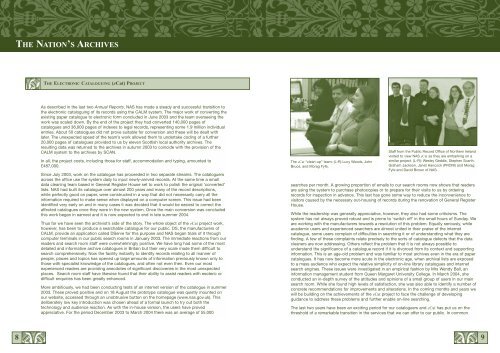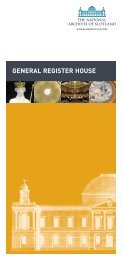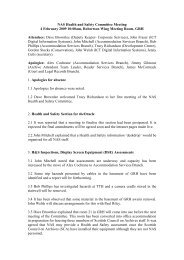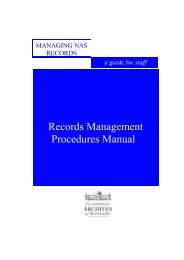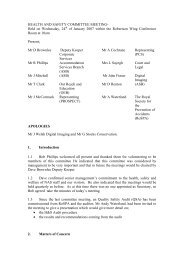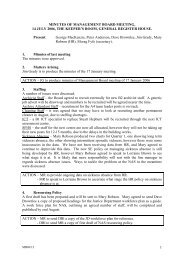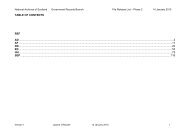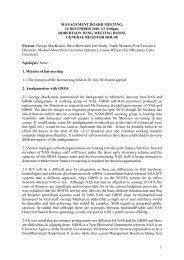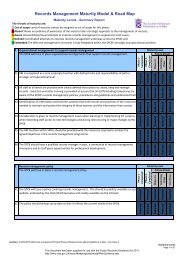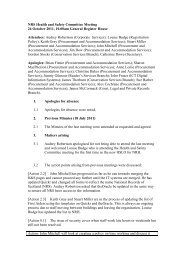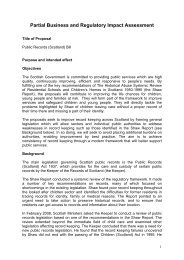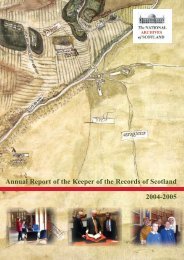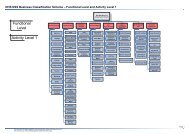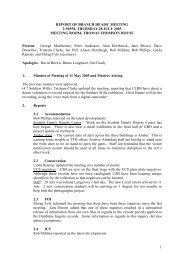Annual Report 2003-2004 - National Archives of Scotland
Annual Report 2003-2004 - National Archives of Scotland
Annual Report 2003-2004 - National Archives of Scotland
You also want an ePaper? Increase the reach of your titles
YUMPU automatically turns print PDFs into web optimized ePapers that Google loves.
THE NATION’S ARCHIVES<br />
THE ELECTRONIC CATALOGUING (eCat) PROJECT<br />
As described in the last two <strong>Annual</strong> <strong>Report</strong>s, NAS has made a steady and successful transition to<br />
the electronic cataloguing <strong>of</strong> its records using the CALM system. The major work <strong>of</strong> converting the<br />
existing paper catalogue to electronic form concluded in June <strong>2003</strong> and the team overseeing the<br />
work was scaled down. By the end <strong>of</strong> the project they had converted 140,000 pages <strong>of</strong><br />
catalogues and 36,000 pages <strong>of</strong> indexes to legal records, representing some 1.9 million individual<br />
entries. About 50 catalogues did not prove suitable for conversion and these will be dealt with<br />
later. The unexpected speed <strong>of</strong> the team’s work allowed them to undertake coding <strong>of</strong> a further<br />
20,000 pages <strong>of</strong> catalogues provided to us by eleven Scottish local authority archives. The<br />
resulting data was returned to the archives in autumn <strong>2003</strong> to coincide with the provision <strong>of</strong> the<br />
CALM system to the archives by SCAN.<br />
In all, the project costs, including those for staff, accommodation and typing, amounted to<br />
£487,000.<br />
Since July <strong>2003</strong>, work on the catalogue has proceeded in two separate streams. The cataloguers<br />
across the <strong>of</strong>fice use the system daily to input newly-arrived records. At the same time a small<br />
data cleaning team based in General Register House set to work to polish the original ‘converted’<br />
lists. NAS had built its catalogue over almost 200 years and many <strong>of</strong> the record descriptions,<br />
while perfectly good on paper, were constructed in a way that did not necessarily carry all the<br />
information required to make sense when displayed on a computer screen. This issue had been<br />
identified very early on and in many cases it was decided that it would be easiest to correct the<br />
affected catalogues once they were in the new system. Once the main conversion was concluded<br />
this work began in earnest and it is now expected to end in late summer <strong>2004</strong>.<br />
Thus far we have seen the archivist’s side <strong>of</strong> the story. The whole object <strong>of</strong> the eCat project work,<br />
however, has been to produce a searchable catalogue for our public. DS, the manufacturers <strong>of</strong><br />
CALM, provide an application called DServe for this purpose and NAS began trials <strong>of</strong> it through<br />
computer terminals in our public search rooms in January <strong>2003</strong>. The immediate reactions from our<br />
readers and search room staff were overwhelmingly positive. We have long had some <strong>of</strong> the most<br />
detailed and informative archive catalogues in Britain but their very scale made them difficult to<br />
search comprehensively. Now the facility instantly to identify records relating to all manner <strong>of</strong><br />
people, places and topics has opened up large amounts <strong>of</strong> information previously known only to<br />
those with specialist knowledge <strong>of</strong> the catalogues, and <strong>of</strong>ten not even then. Even our most<br />
experienced readers are providing anecdotes <strong>of</strong> significant discoveries in the most unexpected<br />
places. Search room staff have likewise found that their ability to assist readers with esoteric or<br />
difficult enquiries has been greatly enhanced.<br />
More ambitiously, we had been conducting tests <strong>of</strong> an internet version <strong>of</strong> the catalogue in summer<br />
<strong>2003</strong>. These proved positive and on 18 August the prototype catalogue was quietly mounted on<br />
our website, accessed through an unobtrusive button on the homepage (www.nas.gov.uk). This<br />
deliberately low key introduction was chosen ahead <strong>of</strong> a formal launch to try out both the<br />
technology and audience reaction. As with the in-house version, the users have proved<br />
appreciative. For the period December <strong>2003</strong> to March <strong>2004</strong> there was an average <strong>of</strong> 55,000<br />
The eCat “clean-up” team: (L-R) Lucy Woods, John<br />
Bruce, and Morag Fyfe.<br />
Staff from the Public Record Office <strong>of</strong> Northern Ireland<br />
visited to view NAS eCat as they are embarking on a<br />
similar project. (L-R): Wesley Geddis, Stephen Scarth,<br />
Graham Jackson, Janet Hancock (PRONI) and Morag<br />
Fyfe and David Brown <strong>of</strong> NAS.<br />
searches per month. A growing proportion <strong>of</strong> emails to our search rooms now shows that readers<br />
are using the system to purchase photocopies or to prepare for their visits to us by ordering<br />
records for inspection in advance. This last has gone some way to reduce the inconvenience to<br />
visitors caused by the necessary out-housing <strong>of</strong> records during the renovation <strong>of</strong> General Register<br />
House.<br />
While the readership was generally appreciative, however, they also had some criticisms. The<br />
system has not always proved robust and is prone to ‘switch <strong>of</strong>f’ in the small hours <strong>of</strong> Sunday. We<br />
are working with the manufacturers towards a resolution <strong>of</strong> this problem. Equally seriously, while<br />
academic users and experienced searchers are almost united in their praise <strong>of</strong> the internet<br />
catalogue, some users complain <strong>of</strong> difficulties in searching it or <strong>of</strong> understanding what they are<br />
finding. A few <strong>of</strong> these complaints relate precisely to the sorts <strong>of</strong> catalogue defects that the data<br />
cleaners are now addressing. Others reflect the problem that it is not always possible to<br />
understand the significance <strong>of</strong> a catalogue record if it is divorced from its context and supporting<br />
information. This is an age-old problem and was familiar to most archives even in the era <strong>of</strong> paper<br />
catalogues. It has now become more acute in the electronic age, when archival lists are exposed<br />
to a mass audience who expect the relative simplicity <strong>of</strong> on-line library catalogues and internet<br />
search engines. These issues were investigated in an empirical fashion by Mrs Wendy Ball, an<br />
information management student from Queen Margaret University College. In March <strong>2004</strong>, she<br />
conducted an in-depth survey <strong>of</strong> the attitudes and opinions <strong>of</strong> a small group <strong>of</strong> users in our main<br />
search room. While she found high levels <strong>of</strong> satisfaction, she was also able to identify a number <strong>of</strong><br />
concrete recommendations for improvements and alterations. In the coming months and years we<br />
will be building on the achievements <strong>of</strong> the eCat project to face the challenge <strong>of</strong> developing<br />
guidance to address these problems and further enable on-line searching.<br />
The last two years have been an exciting period for our cataloguers and eCat has put us on the<br />
threshold <strong>of</strong> a remarkable transition in the services that we can <strong>of</strong>fer to our public. In common<br />
8<br />
9


